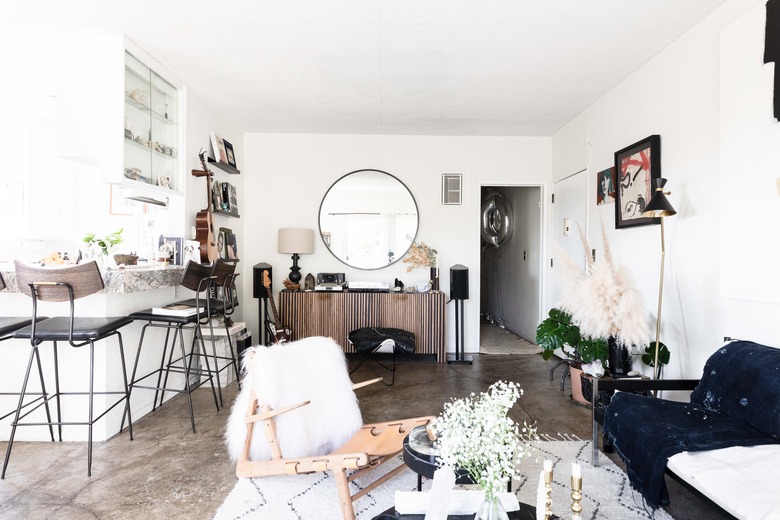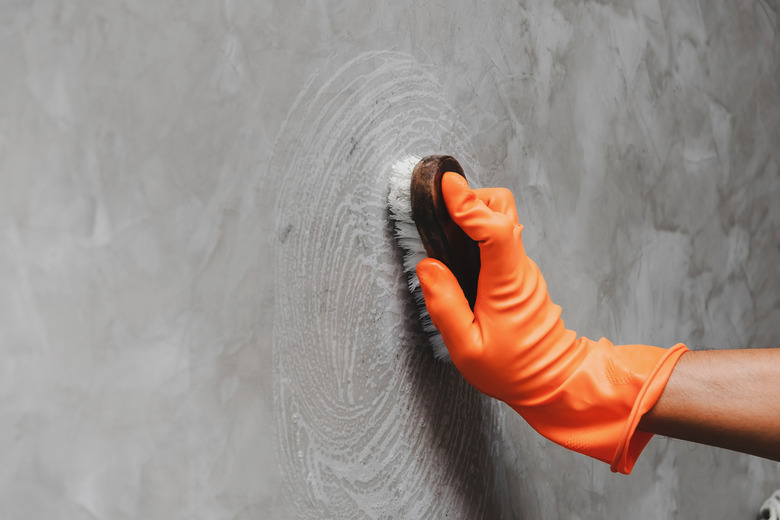Concrete Floor Cleaner: What You Should Know
A concrete floor is one of the easiest floors to keep clean. There are no gaps between floorboards or grout lines to trap dirt, and you can use as much clean water as you want. Nevertheless, you must use an appropriate floor cleaner, or you could end up with problems you'd rather not have.
A concrete floor cleaner can be acidic, alkaline, pH-neutral or enzymatic, and the best choice depends not only on the concrete finish but on the nature of the stains you're trying to remove. You'll seldom hurt anything when you use a pH-neutral cleaner, but it won't handle stubborn stains such as grease, oil, rust or efflorescence (white salt deposits on the concrete surface). For these, you need a cleaner with a bit of bite that only a pH on either side of the neutral zone or a collection of microbial-digesting enzymes can provide.
Choose Your Concrete Floor Cleaner
Choose Your Concrete Floor Cleaner
The safest cleaners are pH-neutral ones, and they are the best option for interior concrete and stone floors that have been sealed. They act to loosen surface dirt so you can scrub and rinse it away, but they won't go deep into unsealed concrete to remove embedded, ground-in dirt. A basic pH-neutral cleaner, which may contain a mildewcide, comes as a concentrate that you mix with water to make a solution that you use to saturate the concrete surface before scrubbing and rinsing with clean water.
If you're cleaning an unsealed concrete slab such as an outdoor patio or a garage floor, you may have to remove grease and oil stains that have soaked in, and for that, you need an alkaline cleaner. It works by converting the oils and greases to water-soluble soaps that you can rinse away by scrubbing or using a power washer. For this reason, an alkaline cleaner, which typically has a pH of 10 or more, is often labeled as concrete degreaser, and you can use it as a neutralizer after using an acidic cleaner.
On the opposite side of the pH-neutral zone, acidic cleaners are best for removing rust stains, leaf stains and efflorescence. They do this by chemically breaking down the compounds that cause the stains, but they also react with the concrete itself, dissolving the bonds that hold it together, so they must be used with caution. An acidic cleaner can be used to etch a smooth concrete surface, which you may want to do if you're planning on painting or sealing the floor after you've cleaned it.
An enzymatic concrete floor cleaner can do many of the same jobs as an acidic or alkaline cleaner, and it's more environmentally friendly, but it takes longer to work because it relies on microbial digestion. This type of cleaner may come as a liquid or a powder that you spread over the surface with a broom and then mist with water. Rinsing usually isn't necessary.
Check for a Sealer Before You Clean
Check for a Sealer Before You Clean
If the floor you're about to clean has a sealer (which may or may not be obvious), this limits your cleaning options because alkaline and acidic cleaners will damage the seal coat. To check for a sealant, sprinkle a few drops of water on the floor, wait about 20 minutes and note whether the water has soaked in, indicating the floor is likely unsealed. If the water beads up on the surface, it is probably sealed.
It's easier to clean a sealed floor because the sealer prevents deep stains from occurring. You can do the job with a pH-neutral cleaner such as dish soap and water or, as recommended by the Washington Post, OxiClean Versatile Stain Remover or a similar oxygen bleach product.
How to Clean a Concrete Floor
How to Clean a Concrete Floor
No matter which floor cleaner you use, some scrubbing or similar abrasive action is bound to be involved to remove stubborn stains. If the floor is in the garage or outdoors, you can use a power washer, which is an effective cleaning tool for concrete. Indoors, a floor buffer with a brush attachment is great for scrubbing areas that are too large to do on your hands and knees with a scrub brush.
1. Move Everything Off the Floor
This seems like an obvious first step, but many people balk at moving heavy items, especially in the garage. However, keep in mind that standing water that collects around the edges of items you leave on a garage floor or anywhere else can soak into unsealed concrete and leave stains that can prove to be difficult to remove.
2. Sweep, Vacuum or Power Wash
Get all loose dirt and debris off the floor. If the floor is unsealed and you wet it down, any dirt you don't remove will sink in and create new stains. If the floor is sealed, sweeping up loose dirt is two-thirds of the job. The rest is easy.
If the floor is outdoors or in the garage, you can power wash in lieu of sweeping because the high water pressure blows the dirt away. If you have a power washer with a soap compartment, add a commercial degreaser to remove oil stains and grime, and if possible, hook up the power washer to a hot-water source so you can wash with warm water, which helps loosen ground-in dirt. After washing with a soap solution, wash again with clean water to rinse the floor.
3. Take Care of Individual Stains
Vinegar is an acidic cleaner that you shouldn't use over the entire floor because of the danger of etching, but it's great for removing individual rust stains and localized efflorescence. Pour it full strength on individual stains and let it soak in for 10 minutes before scrubbing. You can also squeeze lemon juice on the stains, which is just as acidic and works in the same way. After the stain is gone, sprinkle some baking soda on the area to neutralize the acid and rinse with clean water.
An easy way to remove fresh oil stains is to sprinkle cat litter or corn starch on them to soak them up. Leave it for a day or two, and after you sweep it away, pour dish soap, laundry detergent or a commercial cleaner such as Simple Green All-Purpose Cleaner on the spots, scrub them out with a scrub brush and then rinse.
4. Mop the Floor and Rinse
Whether the floor is sealed or not, mopping the entire area with warm water and a pH-neutral cleaning solution is recommended periodically to control grime. It's safe to add chlorine bleach to the solution to kill mildew because bleach isn't acidic and won't cause any damage. If the floor is painted or has a glossy coating, use a product such as Simple Green Multi-Surface Floor Care that you mist on the floor and wipe it away with a wet mop to get a streak-free finish.



